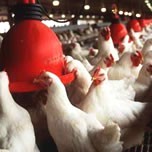Australian process converts rubbish to chicken feed

Would poultry feed made from waste turn out to be nutritious and palatable to poultry? Last May bureaucrats and potential investors in East Java, Indonesia were awaiting the first results from an important local lab analysis.
Two entrepreneurs are willing to set up a project that converts people’s
waste into chicken feed. The businessmen are convinced, but the project, which
needs a US$25 million (about Rp 225 billion) investment, had to convince
people.
“There’s a lot of skeptics in the government, particularly in
animal husbandry, but I’m pretty optimistic,” said Surabayan businessman Ron
Kho. “Once this gets up and running, everyone will want to be
involved.”
His partner, Sam Salpietro from Western Australia, whose
company BioCulture www.bioculture.com.au/ is pushing the idea to
convert (organic) waste into chicken feed. “This is the only project that can be
considered a viable and commercial operation,” he said. “There’s no need for
subsidies or government funding.”
Dissatisfied with local lab procedures,
the partners decided to get another opinion on their product in Australia. But
the idea hit speed bumps. Six months later the partners have their analysis from
the Western Australian government’s chemical laboratory, which they presented to
potential investors in Surabaya recently.
Every day the people of
Indonesia’s second biggest city produce 3,000 tons of rubbish destined for the
dump. The overall quantity is much higher, but efficient scavengers pull tons of
plastic, glass, wood and other recyclable out of the refuse long before it gets
to the landfill.
If one imagines a low-tech process whereby about half of
that waste would be converted into chicken pellets that could be sold at a
profit. The garbage pits would then last twice as long in a land where space is
needed for the living, not for their waste.
“There’s no doubt this
project can only work in developing countries where labour is cheap,” Kho said.
“Most of the work is manual. It requires teams of people sorting through refuse
on a moving table and rejecting everything inorganic.
“The foods and
plants which do get through will be cooked and processed to remove impurities.
Extra nutrients will be added and the mix forced through an extruder to make
pellets.”
Join 26,000+ subscribers
Subscribe to our newsletter to stay updated about all the need-to-know content in the feed sector, three times a week. Beheer
Beheer









 WP Admin
WP Admin  Bewerk bericht
Bewerk bericht